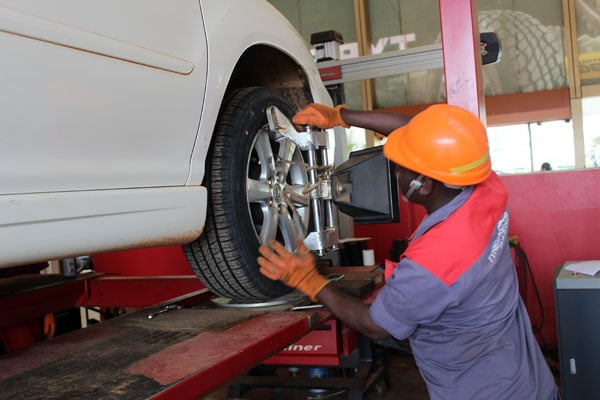Pay attention to tyre maintenance

A tyre technician carries out wheel balance. Photo/Roland D. Nasasira
What you need to know:
- Before you drive away, even if you just replaced your tyres, make it a habit to walk around your car to make sure that all tyres have pressure. It is important to rotate tyres after long distances because they are more susceptible to uneven wear.
Tyre maintenance is one of the most important, yet commonly ignored mechanical aspects of any car. As long as the car has fuel and can start, many people do not take the initiative to check the condition of the tyres.
Saleem Meerasa, the sales manager at Tyre Express Uganda, explains that proper tyre maintenance includes four major components; wheel alignment, tyre rotation, wheel balancing and tyre pressure. All these components play different roles and may sometimes impact on your road safety and driving comfort.
Poor wheel alignment for instance, is primarily caused by bad driving habits such as ramming into potholes and driving over road humps without reducing speed. Wheel alignment, Meerasa says, should be done after driving between 5,000km to 8,000km or every time you feel discomfort or shaking in the wheels as you drive.
Tyre rotation
Tyre rotation is routinely repositioning your vehicle’s tyres in specific patterns from front to back or side to side to make it easy to inspect for any damages, check their air pressure, have them rebalanced if you are noticing any vibration, and check their tread depth.
This is done only if all the tyres are of the same size and use the same size of rims. If you frequently drive upcountry, Meerasa advises that you carry out tyre rotation for every 5,000miles or 8,000km covered as this will increase tyre life.
“Upcountry drives mean you cover long distances and will do service more frequently. It also means that you will replace tyres sooner than later. To increase tyre life, rotate your tyres quite often. Every time they are rotated, make sure they have uniform pressure. Inadequate pressure in one tyre or two means it will wear out faster than expected,” Meerasa explains.
Tyre and rim sizes
Samson Ongada, a mechanic says for station wagons and saloon cars such as the Toyota Fielder or the Toyota Wish, Toyota Premio and any other cars within the same classification, it is advisable to use tyre size 195/65 R15 or 205/65 R15. The tyre size is also determined by the rim size you drive on.
If you drive on rim size 16, you should use tyre size 215/70 R16 and if it is rim size 17, you are recommended to use tyre size 225/65 R17. When it comes to subcompact SUVs such the Toyota Harrier whose latest models are normally fitted with rim size 18, it is advisable to use tyre size 235/60 RI8.
For pick-ups and sport utility vehicles, it is recommended to use rim size 16 or 17 because of their performance and load capacity. This explains why these cars use wider tyres mostly of size 265/70 R16 for SUVs or 265/65 R17.
“Do not use big size tyres because your car has a low ground clearance and you want to raise it. You will be altering with the manufacturer’s specifications and as you drive, you will lose stability because the car will take long to brake. The size of the rims must correspond with the recommended tyre size,” Ongada advises.
Wheel balancing and alignment
If your car has a preference for one direction over the other or is exerting more effort than it ought to, unaligned wheels may be to blame for this. Many cars suffer damage from misaligned wheels and be steered off the course. Wheels that are out of alignment cause poor control and performance in addition to distinctive wear and tear.
Wheel balancing involves using a computerised balancing machine that checks if the rims sit well on the tyres so that the two move at even speeds and rotations.
While poorly balanced rims cause wobbling and in some cases cause other damages to the car, proper balancing on the other side can lead to a smoother ride, less tyre wear, and reduced strain on the drivetrain.
Both balancing and alignment services are usually available but most times confused. A tyre balance corrects the weight imbalance on your tyre while wheel alignment corrects the angles of the tyres so that they come in contact with the road in the right way.
Tyre pressure
“Some drivers add car tyre pressure which is beyond the prescribed measurements, especially when they are either making long journeys or when the car is heavily loaded,” This, Steven Kamotti, a tyre technician, warns, “increases the risk of a tyre bursts which can cause crashes and death.”
“When driving,” he adds, “the tyre accumulates hot air which is pressure itself. It means that any additional pressure will be considered excess and will have nowhere to go. The tyre swells and reduces road grip and the outcome will be tyre bursts.”
Regardless of the road condition where you drive, you can as well use all-terrain tyres, abbreviated as A/T on tyre sides. It is advisable to buy tyres from reputable dealers.
“Do not buy tyres because they have beautifully designed treads and look attractive. The longevity and performance of any tyres goes beyond beauty. What you should understand is that tyres are made of 76 products such as natural and synthetic rubber, and steel wires, among others, all of which have an expiry date,” says Ongada.
Meerasa advises car owners to seek professional guidance from your mechanic and read on tyre sides so that they buy those with a longer expiry date. “One of the many signs that a tyre is expired is when a dealer is selling it at a lower cost than normal,” Meerasa says.
Pressure and fuel consumption
Proper tyre pressure is essential for optimal vehicle performance. Underinflated tyres can increase fuel consumption, as they create more rolling resistance, making the engine work harder. This not only results in higher fuel costs but also contributes to increased CO2 emissions, negatively impacting the environment.
Maintaining the correct tyre pressure provides better handling and stability while driving, reducing the risk of accidents.
Source: advancetyresqld.com.au




